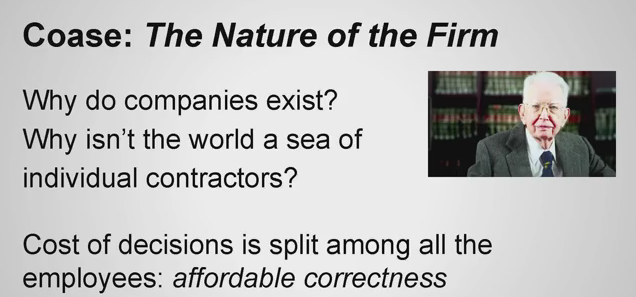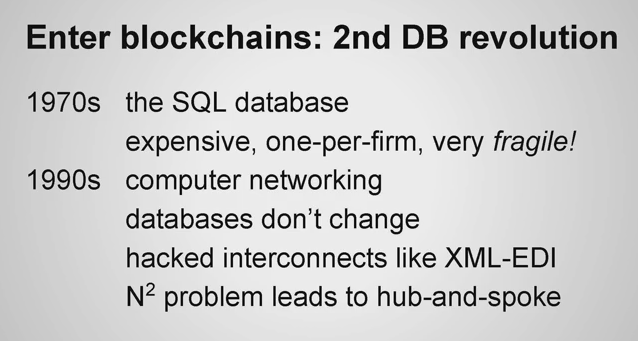June 05, 2015
Coase's Blockchain - the first half block - Vinay Gupta explains triple entry
Editor's Preamble! Back in 1997 I gave a paper on crowdfunding - I believe the first ever proper paper, although there was one "lost talk" earlier by Eric Hughes - at Financial Cryptography 1997. Now, this conference was the first polymath event in the space, and probably the only one in the space, but that story is another day. Because this was a polymath event, law professor who's name escapes Michael Froomkin stood up and asked why I hadn't analysed the crowdfunding system from the point of view of transaction economics.
I blathered - because I'd not heard of it! But I took the cue, went home and read the Ronald Coase paper, and some of his other stuff, and ploughed through the immensely sticky earth of Williamson. Who later joined Coase as a Nobel Laureate.
The prof was right, and I and a few others then turned transaction cost discussion into a cypherpunk topic. Of course, we were one or two decades too early, and hence it all died.
Now, with gusto, Vinay Gupta has revived it all as an explanation of why the blockchain works. Indeed, it's as elegant a description of 'why triple entry' as I've ever heard! So here goes my Saturday writing out Coase's first half block, or the first 5 minutes of Gupta's talk.
 This is the title of the talk - Coase's Blockchain. Does anyone in the audience know who Ronald Coase was? No? Ok. He got the Nobel Prize for Economics in 1940. Coase's question was, why does the company exist as an institution? Theoretically, if markets are more efficient than command economies, because of a better distribution of information, why do we then recreate little pockets of command economy in the form of a thing you call a company?
This is the title of the talk - Coase's Blockchain. Does anyone in the audience know who Ronald Coase was? No? Ok. He got the Nobel Prize for Economics in 1940. Coase's question was, why does the company exist as an institution? Theoretically, if markets are more efficient than command economies, because of a better distribution of information, why do we then recreate little pockets of command economy in the form of a thing you call a company?
And, understanding why the company exists is a critical thing if you want to start companies or operate companies because the question you have to ask is why are we doing this rather than having a market of individual actors. And Coase says, the reason that we don't have seas of contractors, we've got structures like say IBM, is because making good decisions is expensive.
Last time you bought a telephone or a television or a car you probably spent 2 days on the Internet looking at reviews trying to make a decision, right? Familiar experience? All of that is a cost, that in a company is made by purchasing. Same thing for deciding strategy, if you're a small business person you spend a ton of time worrying about strategy, and all of those costs in a large company are amortised across the whole company. The company serves to make decisions and then amortise the costs of the decisions across the entire structure.
 This is all essentially about transaction costs. Now, move onto Venture Capital.
This is all essentially about transaction costs. Now, move onto Venture Capital.
Paul Graham's famous essay "Black Swan Farming." What they basically say is venture capitalists have no idea what will or won't work, we can't tell. We are in the business of guessing winners, but it turns out that our ability to successfully predict is less than one in a hundred. Of a hundred companies we fund, 90 will fail, 10 will make about 10 times what we put into them, and one in about a thousand will make us a ton of money. One thousand to one returns are higher, but we actually have no way of telling which is which, so we just fund everything.
Even with their very large sample size, they are unable to successfully predict what will or will not succeed. And if this is true for venture capitalists, how much truer is it for entrepreneurs? As a venture capitalist, you have an N of maybe 600 or 1000, as an entrepreneur you've got an N of 2 or 3. All entrepreneurs are basically guessing that their thing might work with totally inadequate evidence and no legitimate right to assume their guess is any good because if the VCs can't tell, how the heck is the entrepreneur supposed to tell?
We're in an environment with extremely scarce information about what will or will not succeed and even the people with the best information in the world are still just guessing. The whole thing is just guesswork.
 History of Blockchains in a Nutshell, and I will bring all this back together in time.
History of Blockchains in a Nutshell, and I will bring all this back together in time.
In the 1970s the SQL database was basically a software system that was designed to make it possible to do computation using tape storage. You know how in databases, you have these fixed field lengths, 80 characters 40 characters, all this stuff, it was so that when you fast-forwarded the tape, you knew that each field would take 31 inches and you could fast forward by 41 and a half feet to get to the record you needed next. The entire thing was about tape.
In the 1990s, we invent the computer network, at this point we're running everything across telephone wires, basically this is all pre-Ethernet. It's really really early stuff and then you get Ethernet and standardisation and DNS and the web, the second generation of technology.
The bridges between these systems never worked. Anybody that's tried to connect two corporations across a database knows that it's just an absolute nightmare. You get hacks like XML-EDI or JSON or SOAP or anything like that but you always discover that the two databases have different models of reality and when you interconnect them together in the middle you wind up having to write a third piece of software.
The N-squared problem. So the other problem is that if we've got 50 companies that want to talk to 50 companies you wind up having to write 50-squared interconnectors which results in an unaffordable economic cost of connecting all of these systems together. So you wind up with a hub and spoke architecture where one company acts as the broker, everybody writes a connector to that company, and then that company sells all of you down the river because it has absolute power.
As a result, computers have had very little impact on the structure of business even though they've brought the cost of communication and the cost of knowledge acquisition down to a nickel.
This is where we get back to Coase. The revolution that Coase predicted that computers should bring to business hasn't yet happened, and my thesis is that blockchains is what it takes to get that to run.
Editor again: That was Vinay's first 5m after which he took it across to blockchains. Meanwhile, I'll fork back a little to triple entry.
Recall the triple entry concept as being an extension of double entry: The 700 year old invention of double entry used two recordings as a redundant check to eliminate errors and surface fraud. This allowed the processing of accounting to be so reliable that employed accountants could do it. But accounting's double entries were never accepted outside the company, because as Gupta puts it, companies had "different models of reality."
Triple entry flips it all upside down by having one record come from an independent center, and then that record is distributed back to the two companies of any trade, making for 3 copies. Because we used digital signatures to fix one record, triply recorded, triple entry collapses the double vision of classical accounting's worldview into one reality.
We built triple entry in the 1990s, and ran it successfully, but it may have been an innovationary bridge too far. It may well be that what we were lacking was that critical piece: to overcome the trust factor we needed the blockchain.
On that note, here's another minute of the talk I copied before I realised my task was done!
The blockchain, regardless of all the complicated stuff you've heard about it, is simply a database that works just like the network. A computer network is everywhere and nowhere, nobody really owns it, and everybody cooperates to make it work, all of the nodes participate in the process, and they make the entire thing efficient.
Blockchains are simply databases updated to work on the network. And those databases are ones with different properties than the databases made to run on tape. They're decentralised, you can't edit anything, you can't delete anything, the history is stored perfectly, if you want to make an update you just republish a new version of it, and to ensure the thing has appropriate accountability you use digital signatures.
It's not nearly as complicated as the tech guys in blockchainland will tell you. Yes it's as complicated as the inside of an SQL database. All of your companies run SQL databases, none of you really know how they work, it's going to be just like that with blockchains. Two years you'll forget the word blockchain, you'll just hear database, and it'll mean the same thing. Probably.
Posted by iang at June 5, 2015 08:07 AM